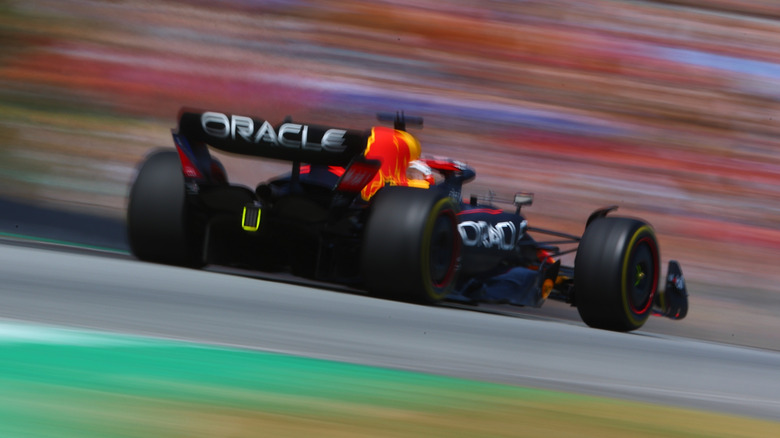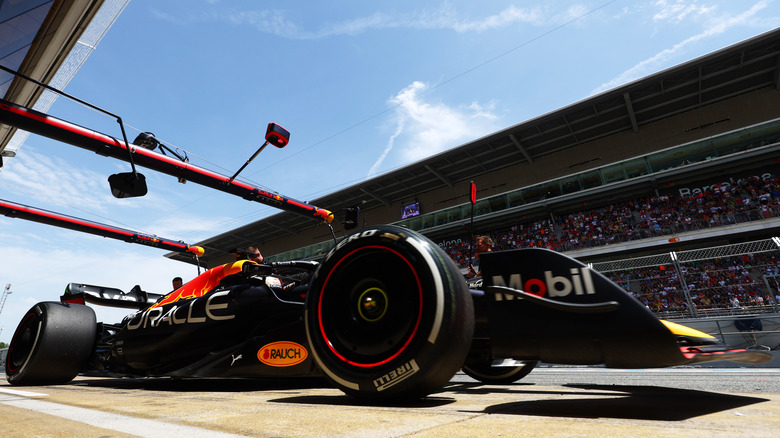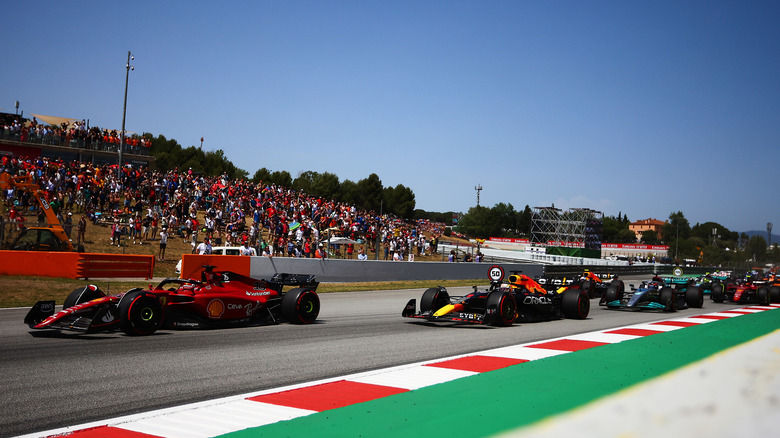Why F1 Winner Max Verstappen Almost Missed The Spanish Grand Prix
The Formula One 2022 Spanish Grand Prix had its fair share of drama. Seven-time F1 world champion Sir Lewis Hamilton offered to retire his Mercedes after clashing with Kevin Magnussen's Haas a few seconds in the first lap. After starting from pole position, Charles Leclerc lost power in his Ferrari on lap 27, allowing Hamilton's teammate George Russell to take the race lead. Sergio Perez and his Red Bull overtook Russell on Lap 31, and Max Verstappen overtook Perez (by design) to take the racing lead on lap 49. Both Red Bull racers never looked back and took first and second place, while Mercedes-Benz took home some crucial points with George Russel in third.
Max Verstappen is defending his crown against the best in the world, but he almost missed the Spanish Grand Prix entirely. Verstappen's Red Bull dealt with DRS issues before the race, and the same problems were plaguing the car on lap 14. If the DRS problems persisted, Verstappen would have had trouble leading the race, but he almost missed the Spanish Grand Prix for a different reason altogether.
Fuel temperature issues
A report from Autosport notes that Verstappen was the last driver to line the grid before the pitlanes were closed by 2:30 pm as mandated by the FIA. Verstappen left the Red Bull garage just seconds after Red Bull sister team Alpha Tauri and driver Pierre Gasly went to the track. Red Bull initially said the delay was due to DRS problems in the car, probably explaining the lingering issues with Vertappen's DRS early in the race. The DRS or Drag Reduction System is a movable flap on the rear wing of an F1 car. Opening the flap reduces aerodynamic drag and gives the vehicle faster acceleration numbers and a higher top speed.
Red Bull didn't mention anything about Pierre Gasly's Alpha Tauri and why it also had to leave the garage later than most, and we seriously doubt it had to do with similar DRS malfunctions. Autosport added that it had something to do with fuel temperature compliance, specifically the FIA regulations on minimum fuel temperature. According to Article 6 of the FIA technical regulations for 2022, the fuel inside the car's tank should not exceed ten degrees centigrade below the official ambient temperature during race day.
According to Article 6.4.2 on Refuelling, "No fuel intended for immediate use in a car may be more than ten degrees centigrade below ambient temperature. When assessing compliance, the ambient temperature will be recorded by the FIA-appointed weather service provider one hour before any practice session or two hours before the race. This information will also be displayed on the timing monitors."
Furthermore, the rule adds: "The temperature of fuel intended for use in a car must be measured via an FIA-approved and sealed sensor."
Too cool for comfort
Auto Motor und Sport further adds that the fuel temperature in the two Red Bull cars did not meet the prescribed value when the pit lane opened 40 minutes before the Spanish Grand Prix. The FIA specified a minimum fuel temperature of 18 degrees for the first five races of the 2022 F1 season, which also means prescribing a 28 degrees ambient temperature for the Grand Prix races in Bahrain, Jeddah, Melbourne, Imola, and Miami. But for Barcelona, the FIA stipulated an official ambient temperature of 35 degrees. According to FIA rules, the fuel in Barcelona should be no cooler than 25 degrees.
Planet F1 claims the FIA suspected Red Bull of cooling the gas for both its RB18 race cars in sweltering-hot Barcelona, which meant the team had to bring the gas up to temperature before the vehicles could leave the garage. Anything colder is denser and is better for performance and range, and colder fuel gives drivers an unfair advantage over other cars running with hotter gas.
Max Verstappen and teammate Sergio Perez had to drive out of the pits eight seconds before the pit lane closed at 2:30 pm, added GP Blog. The Spanish Grand Prix would have ended differently if Red Bull had failed to comply with the FIA's fuel temperature standards, as Verstappen and Perez would have started at the pitlane if they were unable to "heat" their fuel. The same incident occurred at the 2022 Miami Grand Prix when Aston Martin's Sebastian Vettel and Lance Stroll started the race at the pitlane.
Rival teams suspected Verstappen started the race with colder fuel, but the FIA said the car was within the legal fuel temperature after leaving the garage via live monitoring. And that's all she wrote for the 2022 Spanish Grand Prix.


